Research Methodology : Assignment
VerifiedAdded on 2021/02/19
|17
|4284
|98
AI Summary
Contribute Materials
Your contribution can guide someone’s learning journey. Share your
documents today.
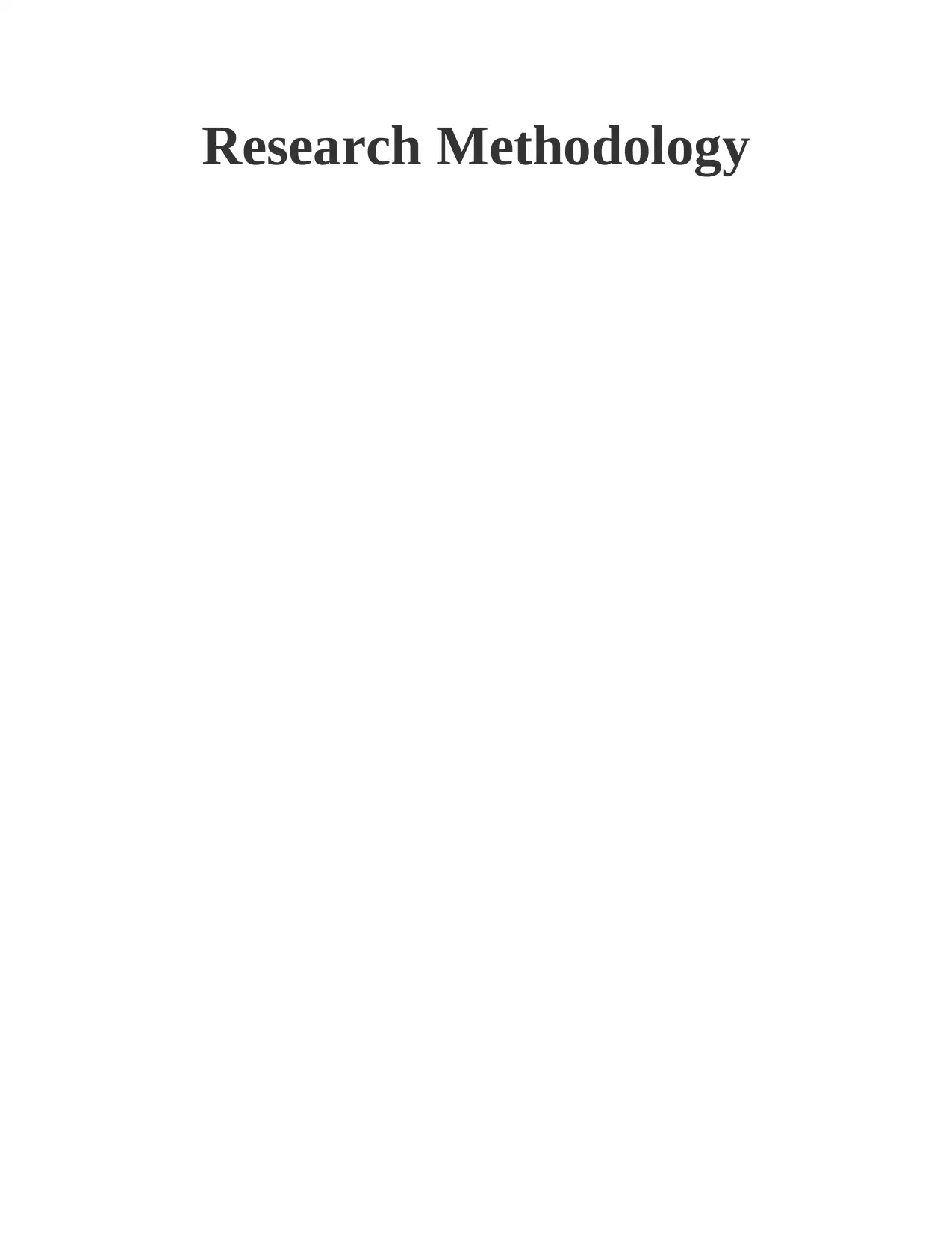
Research Methodology
Secure Best Marks with AI Grader
Need help grading? Try our AI Grader for instant feedback on your assignments.

Table of Contents
CHAPTER 3: METHODOLOGY...................................................................................................3
3.1 Introduction............................................................................................................................3
3.2 Research Philosophy..............................................................................................................3
3.3 Research Design.....................................................................................................................4
3.4 Research Methods..................................................................................................................4
3.5 Sampling................................................................................................................................5
3.5 Data Collection .....................................................................................................................6
3.5.1 Data collection instrument .................................................................................................7
3.5.2 Data collection method ......................................................................................................9
3.6 Data Analysis ........................................................................................................................9
3.6 Data Validity and Reliability..............................................................................................11
3.7 Research Ethics ...................................................................................................................11
3.8 Research Limitation............................................................................................................12
3.9 Conclusion...........................................................................................................................12
REFERENCES..............................................................................................................................14
Books and Journals....................................................................................................................14
CHAPTER 3: METHODOLOGY...................................................................................................3
3.1 Introduction............................................................................................................................3
3.2 Research Philosophy..............................................................................................................3
3.3 Research Design.....................................................................................................................4
3.4 Research Methods..................................................................................................................4
3.5 Sampling................................................................................................................................5
3.5 Data Collection .....................................................................................................................6
3.5.1 Data collection instrument .................................................................................................7
3.5.2 Data collection method ......................................................................................................9
3.6 Data Analysis ........................................................................................................................9
3.6 Data Validity and Reliability..............................................................................................11
3.7 Research Ethics ...................................................................................................................11
3.8 Research Limitation............................................................................................................12
3.9 Conclusion...........................................................................................................................12
REFERENCES..............................................................................................................................14
Books and Journals....................................................................................................................14
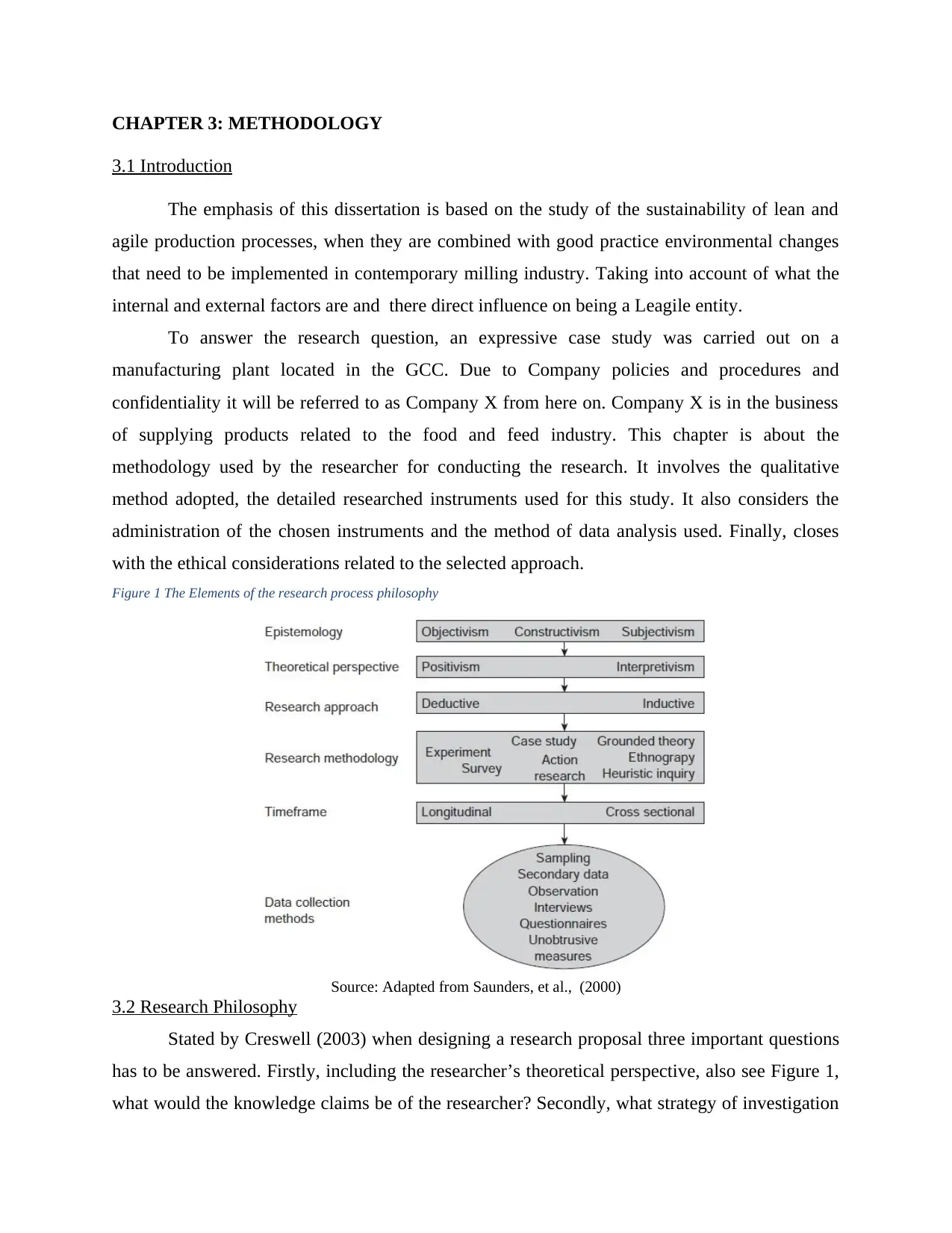
CHAPTER 3: METHODOLOGY
3.1 Introduction
The emphasis of this dissertation is based on the study of the sustainability of lean and
agile production processes, when they are combined with good practice environmental changes
that need to be implemented in contemporary milling industry. Taking into account of what the
internal and external factors are and there direct influence on being a Leagile entity.
To answer the research question, an expressive case study was carried out on a
manufacturing plant located in the GCC. Due to Company policies and procedures and
confidentiality it will be referred to as Company X from here on. Company X is in the business
of supplying products related to the food and feed industry. This chapter is about the
methodology used by the researcher for conducting the research. It involves the qualitative
method adopted, the detailed researched instruments used for this study. It also considers the
administration of the chosen instruments and the method of data analysis used. Finally, closes
with the ethical considerations related to the selected approach.
Figure 1 The Elements of the research process philosophy
Source: Adapted from Saunders, et al., (2000)
3.2 Research Philosophy
Stated by Creswell (2003) when designing a research proposal three important questions
has to be answered. Firstly, including the researcher’s theoretical perspective, also see Figure 1,
what would the knowledge claims be of the researcher? Secondly, what strategy of investigation
3.1 Introduction
The emphasis of this dissertation is based on the study of the sustainability of lean and
agile production processes, when they are combined with good practice environmental changes
that need to be implemented in contemporary milling industry. Taking into account of what the
internal and external factors are and there direct influence on being a Leagile entity.
To answer the research question, an expressive case study was carried out on a
manufacturing plant located in the GCC. Due to Company policies and procedures and
confidentiality it will be referred to as Company X from here on. Company X is in the business
of supplying products related to the food and feed industry. This chapter is about the
methodology used by the researcher for conducting the research. It involves the qualitative
method adopted, the detailed researched instruments used for this study. It also considers the
administration of the chosen instruments and the method of data analysis used. Finally, closes
with the ethical considerations related to the selected approach.
Figure 1 The Elements of the research process philosophy
Source: Adapted from Saunders, et al., (2000)
3.2 Research Philosophy
Stated by Creswell (2003) when designing a research proposal three important questions
has to be answered. Firstly, including the researcher’s theoretical perspective, also see Figure 1,
what would the knowledge claims be of the researcher? Secondly, what strategy of investigation
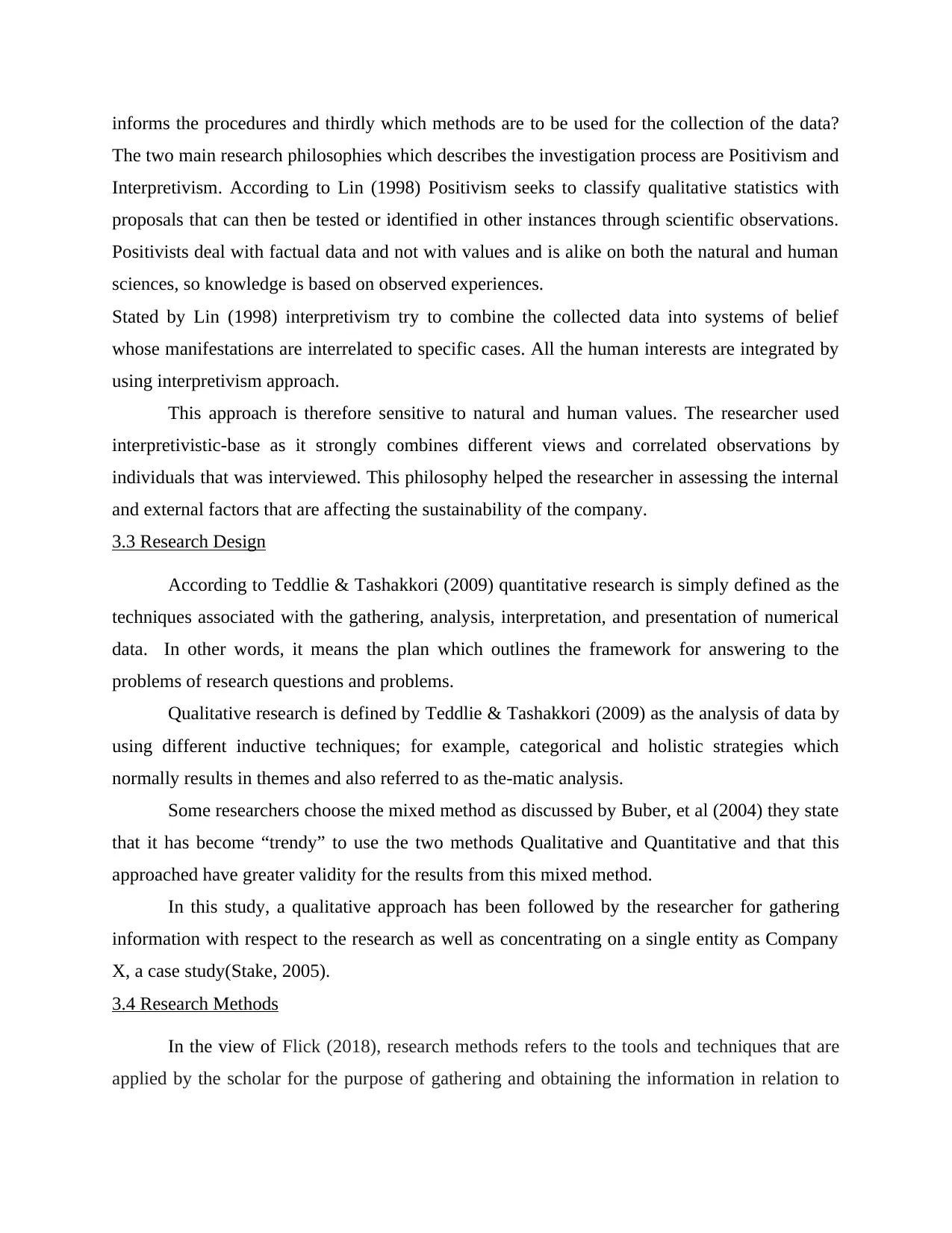
informs the procedures and thirdly which methods are to be used for the collection of the data?
The two main research philosophies which describes the investigation process are Positivism and
Interpretivism. According to Lin (1998) Positivism seeks to classify qualitative statistics with
proposals that can then be tested or identified in other instances through scientific observations.
Positivists deal with factual data and not with values and is alike on both the natural and human
sciences, so knowledge is based on observed experiences.
Stated by Lin (1998) interpretivism try to combine the collected data into systems of belief
whose manifestations are interrelated to specific cases. All the human interests are integrated by
using interpretivism approach.
This approach is therefore sensitive to natural and human values. The researcher used
interpretivistic-base as it strongly combines different views and correlated observations by
individuals that was interviewed. This philosophy helped the researcher in assessing the internal
and external factors that are affecting the sustainability of the company.
3.3 Research Design
According to Teddlie & Tashakkori (2009) quantitative research is simply defined as the
techniques associated with the gathering, analysis, interpretation, and presentation of numerical
data. In other words, it means the plan which outlines the framework for answering to the
problems of research questions and problems.
Qualitative research is defined by Teddlie & Tashakkori (2009) as the analysis of data by
using different inductive techniques; for example, categorical and holistic strategies which
normally results in themes and also referred to as the-matic analysis.
Some researchers choose the mixed method as discussed by Buber, et al (2004) they state
that it has become “trendy” to use the two methods Qualitative and Quantitative and that this
approached have greater validity for the results from this mixed method.
In this study, a qualitative approach has been followed by the researcher for gathering
information with respect to the research as well as concentrating on a single entity as Company
X, a case study(Stake, 2005).
3.4 Research Methods
In the view of Flick (2018), research methods refers to the tools and techniques that are
applied by the scholar for the purpose of gathering and obtaining the information in relation to
The two main research philosophies which describes the investigation process are Positivism and
Interpretivism. According to Lin (1998) Positivism seeks to classify qualitative statistics with
proposals that can then be tested or identified in other instances through scientific observations.
Positivists deal with factual data and not with values and is alike on both the natural and human
sciences, so knowledge is based on observed experiences.
Stated by Lin (1998) interpretivism try to combine the collected data into systems of belief
whose manifestations are interrelated to specific cases. All the human interests are integrated by
using interpretivism approach.
This approach is therefore sensitive to natural and human values. The researcher used
interpretivistic-base as it strongly combines different views and correlated observations by
individuals that was interviewed. This philosophy helped the researcher in assessing the internal
and external factors that are affecting the sustainability of the company.
3.3 Research Design
According to Teddlie & Tashakkori (2009) quantitative research is simply defined as the
techniques associated with the gathering, analysis, interpretation, and presentation of numerical
data. In other words, it means the plan which outlines the framework for answering to the
problems of research questions and problems.
Qualitative research is defined by Teddlie & Tashakkori (2009) as the analysis of data by
using different inductive techniques; for example, categorical and holistic strategies which
normally results in themes and also referred to as the-matic analysis.
Some researchers choose the mixed method as discussed by Buber, et al (2004) they state
that it has become “trendy” to use the two methods Qualitative and Quantitative and that this
approached have greater validity for the results from this mixed method.
In this study, a qualitative approach has been followed by the researcher for gathering
information with respect to the research as well as concentrating on a single entity as Company
X, a case study(Stake, 2005).
3.4 Research Methods
In the view of Flick (2018), research methods refers to the tools and techniques that are
applied by the scholar for the purpose of gathering and obtaining the information in relation to
Secure Best Marks with AI Grader
Need help grading? Try our AI Grader for instant feedback on your assignments.
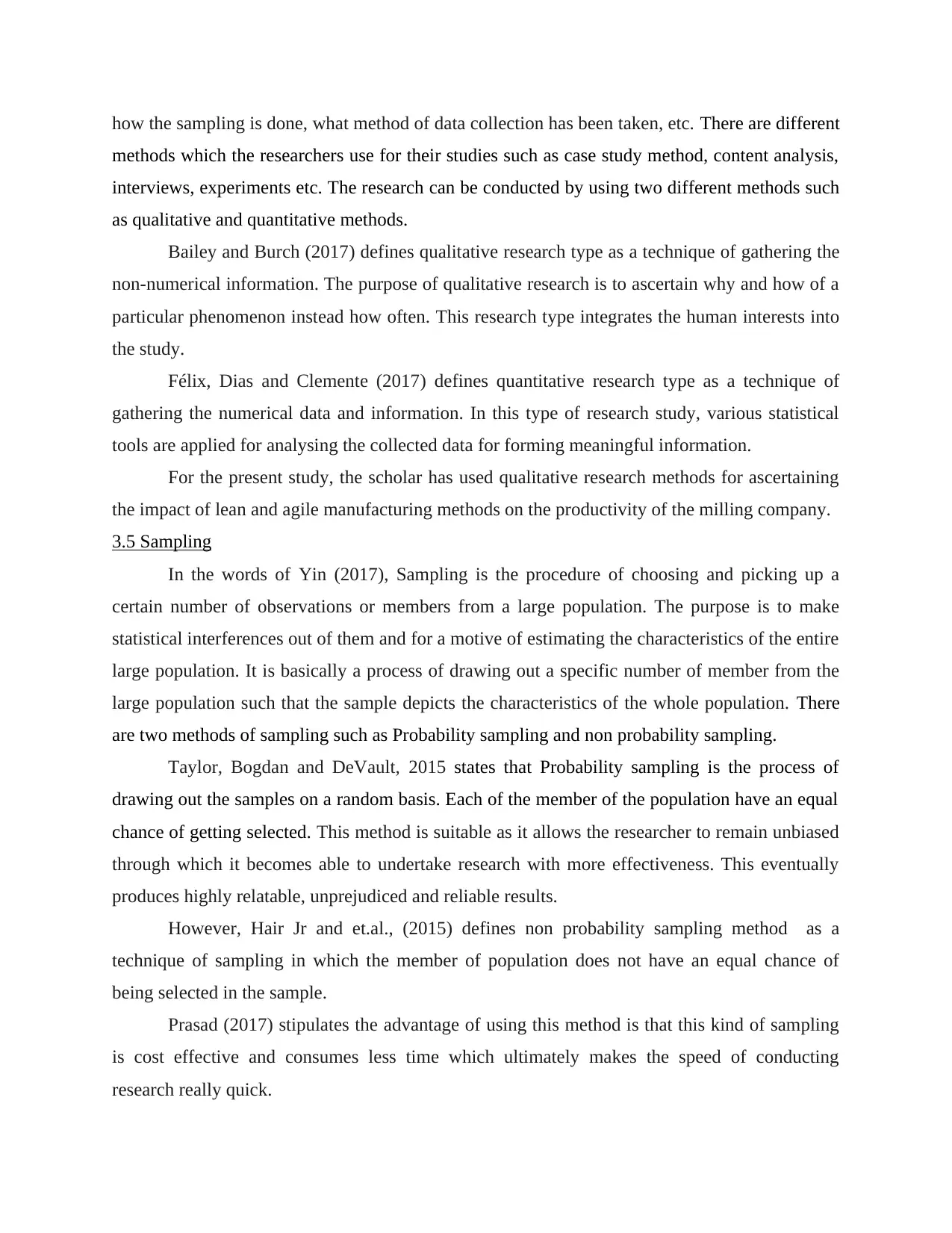
how the sampling is done, what method of data collection has been taken, etc. There are different
methods which the researchers use for their studies such as case study method, content analysis,
interviews, experiments etc. The research can be conducted by using two different methods such
as qualitative and quantitative methods.
Bailey and Burch (2017) defines qualitative research type as a technique of gathering the
non-numerical information. The purpose of qualitative research is to ascertain why and how of a
particular phenomenon instead how often. This research type integrates the human interests into
the study.
Félix, Dias and Clemente (2017) defines quantitative research type as a technique of
gathering the numerical data and information. In this type of research study, various statistical
tools are applied for analysing the collected data for forming meaningful information.
For the present study, the scholar has used qualitative research methods for ascertaining
the impact of lean and agile manufacturing methods on the productivity of the milling company.
3.5 Sampling
In the words of Yin (2017), Sampling is the procedure of choosing and picking up a
certain number of observations or members from a large population. The purpose is to make
statistical interferences out of them and for a motive of estimating the characteristics of the entire
large population. It is basically a process of drawing out a specific number of member from the
large population such that the sample depicts the characteristics of the whole population. There
are two methods of sampling such as Probability sampling and non probability sampling.
Taylor, Bogdan and DeVault, 2015 states that Probability sampling is the process of
drawing out the samples on a random basis. Each of the member of the population have an equal
chance of getting selected. This method is suitable as it allows the researcher to remain unbiased
through which it becomes able to undertake research with more effectiveness. This eventually
produces highly relatable, unprejudiced and reliable results.
However, Hair Jr and et.al., (2015) defines non probability sampling method as a
technique of sampling in which the member of population does not have an equal chance of
being selected in the sample.
Prasad (2017) stipulates the advantage of using this method is that this kind of sampling
is cost effective and consumes less time which ultimately makes the speed of conducting
research really quick.
methods which the researchers use for their studies such as case study method, content analysis,
interviews, experiments etc. The research can be conducted by using two different methods such
as qualitative and quantitative methods.
Bailey and Burch (2017) defines qualitative research type as a technique of gathering the
non-numerical information. The purpose of qualitative research is to ascertain why and how of a
particular phenomenon instead how often. This research type integrates the human interests into
the study.
Félix, Dias and Clemente (2017) defines quantitative research type as a technique of
gathering the numerical data and information. In this type of research study, various statistical
tools are applied for analysing the collected data for forming meaningful information.
For the present study, the scholar has used qualitative research methods for ascertaining
the impact of lean and agile manufacturing methods on the productivity of the milling company.
3.5 Sampling
In the words of Yin (2017), Sampling is the procedure of choosing and picking up a
certain number of observations or members from a large population. The purpose is to make
statistical interferences out of them and for a motive of estimating the characteristics of the entire
large population. It is basically a process of drawing out a specific number of member from the
large population such that the sample depicts the characteristics of the whole population. There
are two methods of sampling such as Probability sampling and non probability sampling.
Taylor, Bogdan and DeVault, 2015 states that Probability sampling is the process of
drawing out the samples on a random basis. Each of the member of the population have an equal
chance of getting selected. This method is suitable as it allows the researcher to remain unbiased
through which it becomes able to undertake research with more effectiveness. This eventually
produces highly relatable, unprejudiced and reliable results.
However, Hair Jr and et.al., (2015) defines non probability sampling method as a
technique of sampling in which the member of population does not have an equal chance of
being selected in the sample.
Prasad (2017) stipulates the advantage of using this method is that this kind of sampling
is cost effective and consumes less time which ultimately makes the speed of conducting
research really quick.
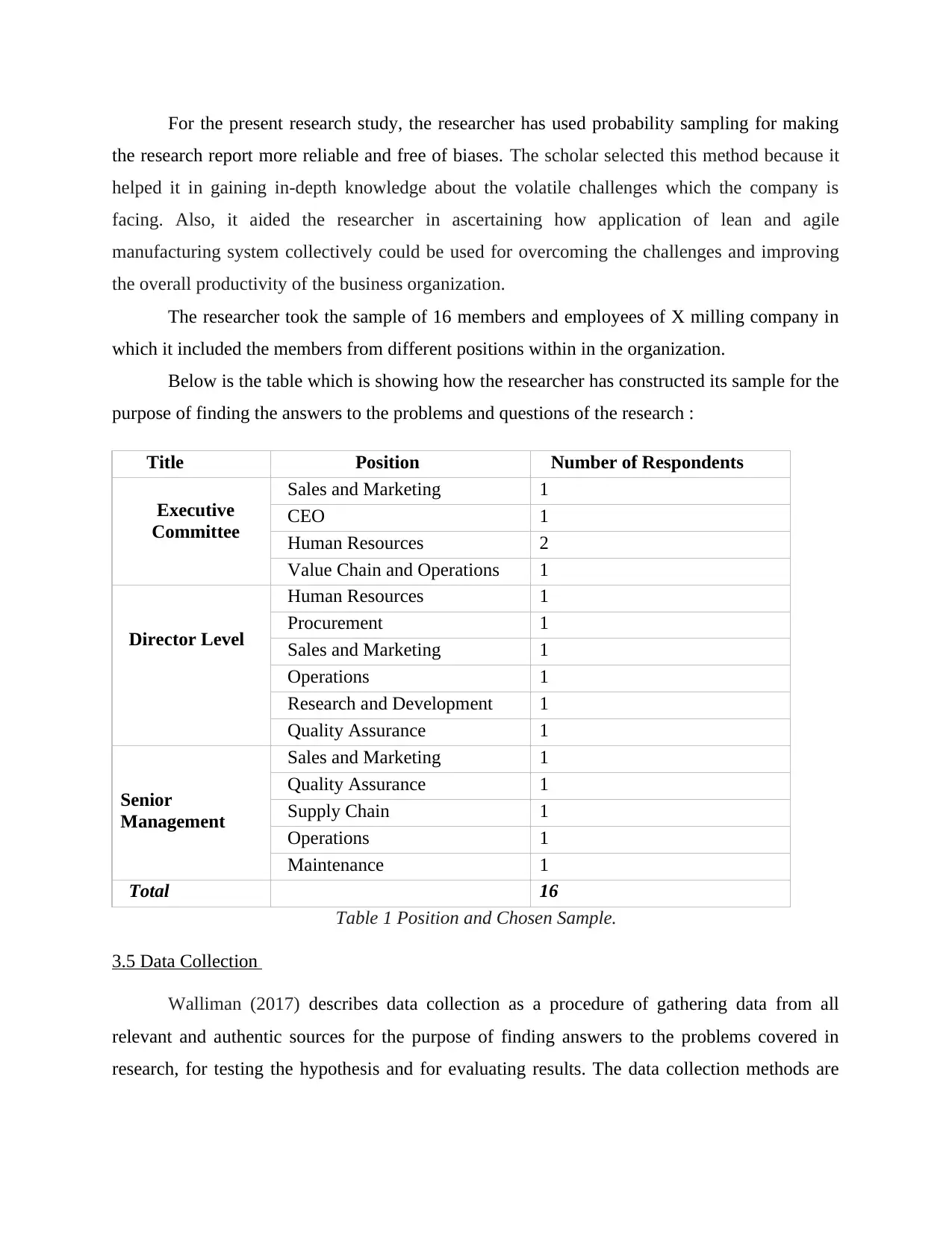
For the present research study, the researcher has used probability sampling for making
the research report more reliable and free of biases. The scholar selected this method because it
helped it in gaining in-depth knowledge about the volatile challenges which the company is
facing. Also, it aided the researcher in ascertaining how application of lean and agile
manufacturing system collectively could be used for overcoming the challenges and improving
the overall productivity of the business organization.
The researcher took the sample of 16 members and employees of X milling company in
which it included the members from different positions within in the organization.
Below is the table which is showing how the researcher has constructed its sample for the
purpose of finding the answers to the problems and questions of the research :
Title Position Number of Respondents
Executive
Committee
Sales and Marketing 1
CEO 1
Human Resources 2
Value Chain and Operations 1
Director Level
Human Resources 1
Procurement 1
Sales and Marketing 1
Operations 1
Research and Development 1
Quality Assurance 1
Senior
Management
Sales and Marketing 1
Quality Assurance 1
Supply Chain 1
Operations 1
Maintenance 1
Total 16
Table 1 Position and Chosen Sample.
3.5 Data Collection
Walliman (2017) describes data collection as a procedure of gathering data from all
relevant and authentic sources for the purpose of finding answers to the problems covered in
research, for testing the hypothesis and for evaluating results. The data collection methods are
the research report more reliable and free of biases. The scholar selected this method because it
helped it in gaining in-depth knowledge about the volatile challenges which the company is
facing. Also, it aided the researcher in ascertaining how application of lean and agile
manufacturing system collectively could be used for overcoming the challenges and improving
the overall productivity of the business organization.
The researcher took the sample of 16 members and employees of X milling company in
which it included the members from different positions within in the organization.
Below is the table which is showing how the researcher has constructed its sample for the
purpose of finding the answers to the problems and questions of the research :
Title Position Number of Respondents
Executive
Committee
Sales and Marketing 1
CEO 1
Human Resources 2
Value Chain and Operations 1
Director Level
Human Resources 1
Procurement 1
Sales and Marketing 1
Operations 1
Research and Development 1
Quality Assurance 1
Senior
Management
Sales and Marketing 1
Quality Assurance 1
Supply Chain 1
Operations 1
Maintenance 1
Total 16
Table 1 Position and Chosen Sample.
3.5 Data Collection
Walliman (2017) describes data collection as a procedure of gathering data from all
relevant and authentic sources for the purpose of finding answers to the problems covered in
research, for testing the hypothesis and for evaluating results. The data collection methods are

divided into two categories such as primary and secondary method. Primary data collection
method is more preferrable as it leads to more reliable, fresh and in-depth information
However, in the views of Patten and Newhart (2017), secondary method of data
colelction is such a technique of collecting and assembling the data from the existing knowledge.
Secondary data collection sources includes Government publications, business reports, Journals,
Internet sources, articles, newspaper etc.
Basias and Pollalis (2018) states that gathering the information from already available
data helps researcher in collecting the needed information very quickly and aids it in completing
the research study on time. Further, it is also cost effective which reduces the funds requirements
of the researcher.
In the present research study, the researcher has used primary data collection method.
The researcher interviewed the respondents and asked them various questions which were related
to the research study. This method was selected by the scholar because it helped the researcher in
assessing the information directly from the sampling population for getting more reliable,
authentic information related to the study through which appropriate recommendations could be
given. This method helped the researcher in knowing the influence of external and internal
factors on the sustainability of the X company.
3.5.1 Data collection instrument
The researcher has used personal interview as a primary data collection instrument in
which it interviewed the people who were the 16 employees and members of the X milling
company.
Below is the interview questions arranged and asked by the researcher from the
employees and members of the milling organisation :
Themes Chapter 3 Interview Questions
Theme 1: Is to determine the
most volatile challenges that a
milling firm may encounter.
1. In your opinion what are the processes that
constrain innovation in your company/department,
especially focusing on the Leagile environment?
(Examples: Management and leadership,
Organizational culture, Teamwork and concurrent
method is more preferrable as it leads to more reliable, fresh and in-depth information
However, in the views of Patten and Newhart (2017), secondary method of data
colelction is such a technique of collecting and assembling the data from the existing knowledge.
Secondary data collection sources includes Government publications, business reports, Journals,
Internet sources, articles, newspaper etc.
Basias and Pollalis (2018) states that gathering the information from already available
data helps researcher in collecting the needed information very quickly and aids it in completing
the research study on time. Further, it is also cost effective which reduces the funds requirements
of the researcher.
In the present research study, the researcher has used primary data collection method.
The researcher interviewed the respondents and asked them various questions which were related
to the research study. This method was selected by the scholar because it helped the researcher in
assessing the information directly from the sampling population for getting more reliable,
authentic information related to the study through which appropriate recommendations could be
given. This method helped the researcher in knowing the influence of external and internal
factors on the sustainability of the X company.
3.5.1 Data collection instrument
The researcher has used personal interview as a primary data collection instrument in
which it interviewed the people who were the 16 employees and members of the X milling
company.
Below is the interview questions arranged and asked by the researcher from the
employees and members of the milling organisation :
Themes Chapter 3 Interview Questions
Theme 1: Is to determine the
most volatile challenges that a
milling firm may encounter.
1. In your opinion what are the processes that
constrain innovation in your company/department,
especially focusing on the Leagile environment?
(Examples: Management and leadership,
Organizational culture, Teamwork and concurrent
Paraphrase This Document
Need a fresh take? Get an instant paraphrase of this document with our AI Paraphraser
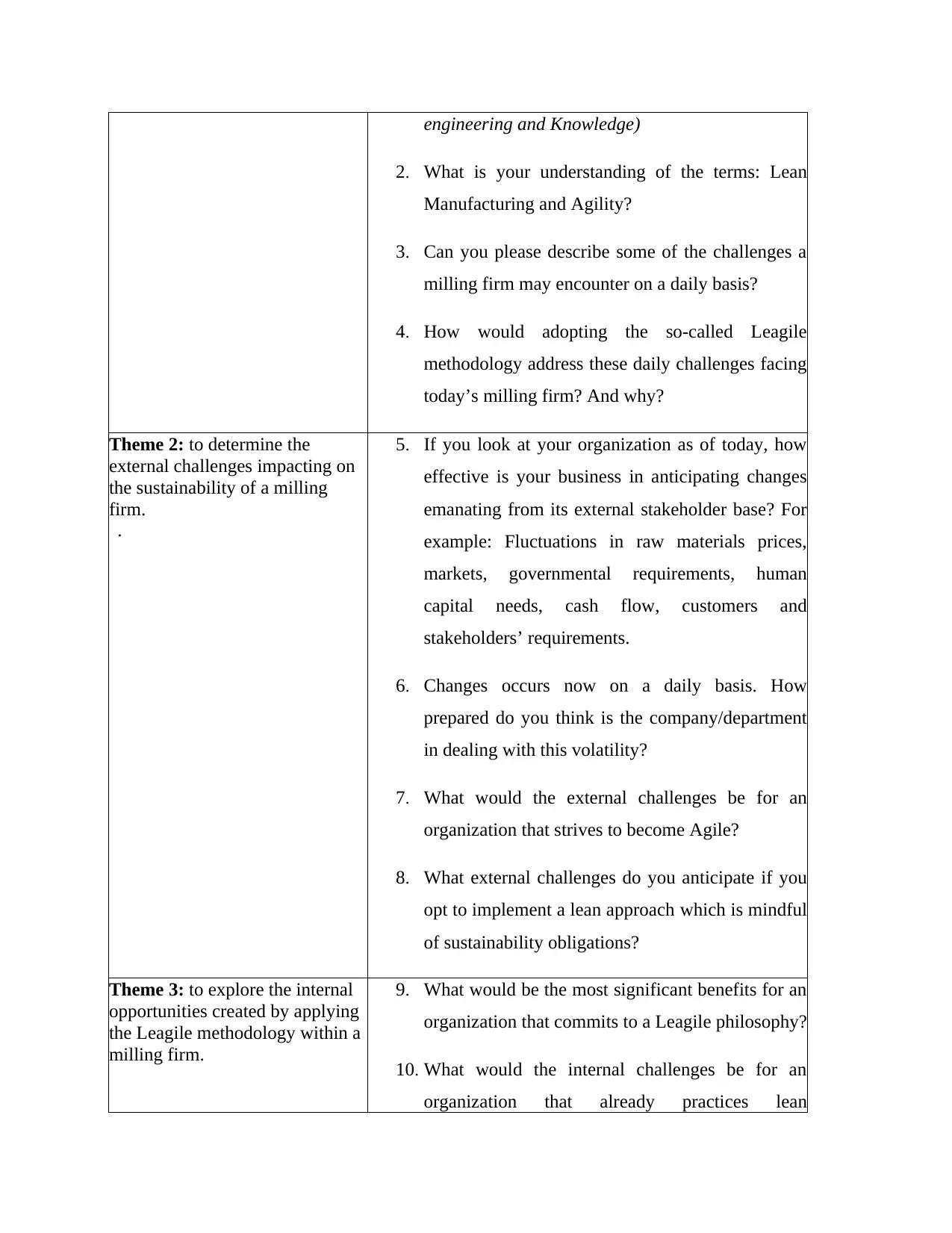
engineering and Knowledge)
2. What is your understanding of the terms: Lean
Manufacturing and Agility?
3. Can you please describe some of the challenges a
milling firm may encounter on a daily basis?
4. How would adopting the so-called Leagile
methodology address these daily challenges facing
today’s milling firm? And why?
Theme 2: to determine the
external challenges impacting on
the sustainability of a milling
firm.
.
5. If you look at your organization as of today, how
effective is your business in anticipating changes
emanating from its external stakeholder base? For
example: Fluctuations in raw materials prices,
markets, governmental requirements, human
capital needs, cash flow, customers and
stakeholders’ requirements.
6. Changes occurs now on a daily basis. How
prepared do you think is the company/department
in dealing with this volatility?
7. What would the external challenges be for an
organization that strives to become Agile?
8. What external challenges do you anticipate if you
opt to implement a lean approach which is mindful
of sustainability obligations?
Theme 3: to explore the internal
opportunities created by applying
the Leagile methodology within a
milling firm.
9. What would be the most significant benefits for an
organization that commits to a Leagile philosophy?
10. What would the internal challenges be for an
organization that already practices lean
2. What is your understanding of the terms: Lean
Manufacturing and Agility?
3. Can you please describe some of the challenges a
milling firm may encounter on a daily basis?
4. How would adopting the so-called Leagile
methodology address these daily challenges facing
today’s milling firm? And why?
Theme 2: to determine the
external challenges impacting on
the sustainability of a milling
firm.
.
5. If you look at your organization as of today, how
effective is your business in anticipating changes
emanating from its external stakeholder base? For
example: Fluctuations in raw materials prices,
markets, governmental requirements, human
capital needs, cash flow, customers and
stakeholders’ requirements.
6. Changes occurs now on a daily basis. How
prepared do you think is the company/department
in dealing with this volatility?
7. What would the external challenges be for an
organization that strives to become Agile?
8. What external challenges do you anticipate if you
opt to implement a lean approach which is mindful
of sustainability obligations?
Theme 3: to explore the internal
opportunities created by applying
the Leagile methodology within a
milling firm.
9. What would be the most significant benefits for an
organization that commits to a Leagile philosophy?
10. What would the internal challenges be for an
organization that already practices lean
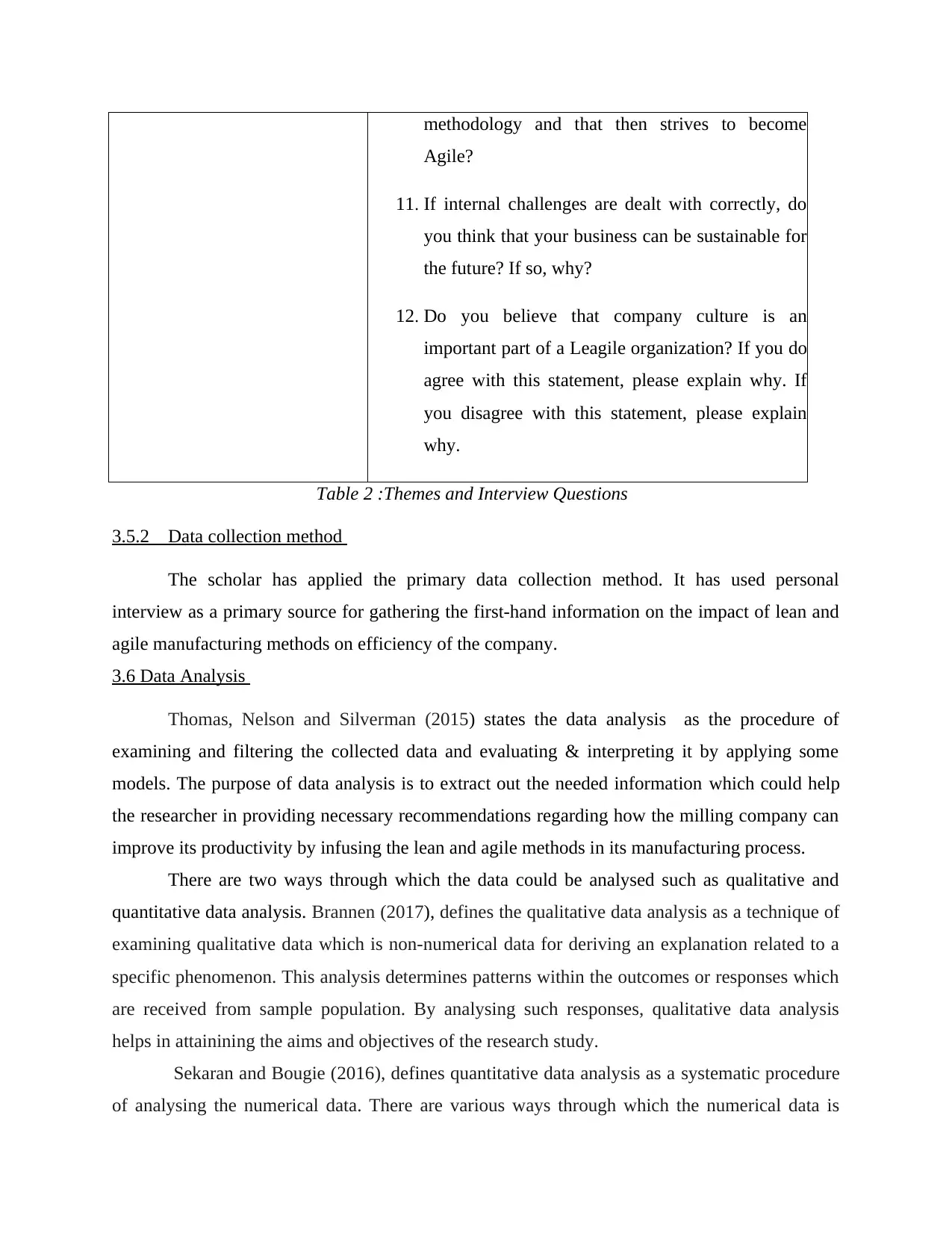
methodology and that then strives to become
Agile?
11. If internal challenges are dealt with correctly, do
you think that your business can be sustainable for
the future? If so, why?
12. Do you believe that company culture is an
important part of a Leagile organization? If you do
agree with this statement, please explain why. If
you disagree with this statement, please explain
why.
Table 2 :Themes and Interview Questions
3.5.2 Data collection method
The scholar has applied the primary data collection method. It has used personal
interview as a primary source for gathering the first-hand information on the impact of lean and
agile manufacturing methods on efficiency of the company.
3.6 Data Analysis
Thomas, Nelson and Silverman (2015) states the data analysis as the procedure of
examining and filtering the collected data and evaluating & interpreting it by applying some
models. The purpose of data analysis is to extract out the needed information which could help
the researcher in providing necessary recommendations regarding how the milling company can
improve its productivity by infusing the lean and agile methods in its manufacturing process.
There are two ways through which the data could be analysed such as qualitative and
quantitative data analysis. Brannen (2017), defines the qualitative data analysis as a technique of
examining qualitative data which is non-numerical data for deriving an explanation related to a
specific phenomenon. This analysis determines patterns within the outcomes or responses which
are received from sample population. By analysing such responses, qualitative data analysis
helps in attainining the aims and objectives of the research study.
Sekaran and Bougie (2016), defines quantitative data analysis as a systematic procedure
of analysing the numerical data. There are various ways through which the numerical data is
Agile?
11. If internal challenges are dealt with correctly, do
you think that your business can be sustainable for
the future? If so, why?
12. Do you believe that company culture is an
important part of a Leagile organization? If you do
agree with this statement, please explain why. If
you disagree with this statement, please explain
why.
Table 2 :Themes and Interview Questions
3.5.2 Data collection method
The scholar has applied the primary data collection method. It has used personal
interview as a primary source for gathering the first-hand information on the impact of lean and
agile manufacturing methods on efficiency of the company.
3.6 Data Analysis
Thomas, Nelson and Silverman (2015) states the data analysis as the procedure of
examining and filtering the collected data and evaluating & interpreting it by applying some
models. The purpose of data analysis is to extract out the needed information which could help
the researcher in providing necessary recommendations regarding how the milling company can
improve its productivity by infusing the lean and agile methods in its manufacturing process.
There are two ways through which the data could be analysed such as qualitative and
quantitative data analysis. Brannen (2017), defines the qualitative data analysis as a technique of
examining qualitative data which is non-numerical data for deriving an explanation related to a
specific phenomenon. This analysis determines patterns within the outcomes or responses which
are received from sample population. By analysing such responses, qualitative data analysis
helps in attainining the aims and objectives of the research study.
Sekaran and Bougie (2016), defines quantitative data analysis as a systematic procedure
of analysing the numerical data. There are various ways through which the numerical data is
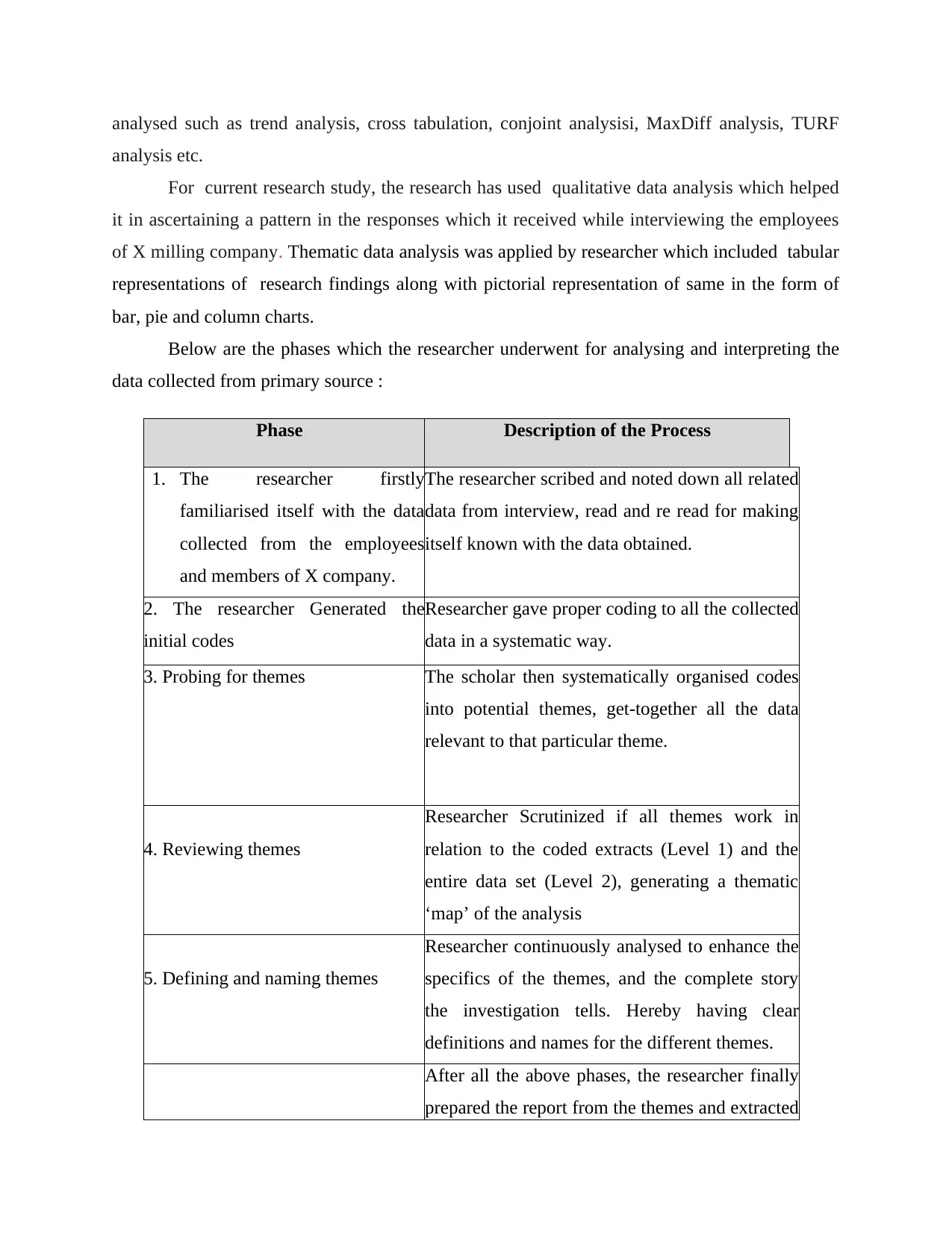
analysed such as trend analysis, cross tabulation, conjoint analysisi, MaxDiff analysis, TURF
analysis etc.
For current research study, the research has used qualitative data analysis which helped
it in ascertaining a pattern in the responses which it received while interviewing the employees
of X milling company. Thematic data analysis was applied by researcher which included tabular
representations of research findings along with pictorial representation of same in the form of
bar, pie and column charts.
Below are the phases which the researcher underwent for analysing and interpreting the
data collected from primary source :
Phase Description of the Process
1. The researcher firstly
familiarised itself with the data
collected from the employees
and members of X company.
The researcher scribed and noted down all related
data from interview, read and re read for making
itself known with the data obtained.
2. The researcher Generated the
initial codes
Researcher gave proper coding to all the collected
data in a systematic way.
3. Probing for themes The scholar then systematically organised codes
into potential themes, get-together all the data
relevant to that particular theme.
4. Reviewing themes
Researcher Scrutinized if all themes work in
relation to the coded extracts (Level 1) and the
entire data set (Level 2), generating a thematic
‘map’ of the analysis
5. Defining and naming themes
Researcher continuously analysed to enhance the
specifics of the themes, and the complete story
the investigation tells. Hereby having clear
definitions and names for the different themes.
After all the above phases, the researcher finally
prepared the report from the themes and extracted
analysis etc.
For current research study, the research has used qualitative data analysis which helped
it in ascertaining a pattern in the responses which it received while interviewing the employees
of X milling company. Thematic data analysis was applied by researcher which included tabular
representations of research findings along with pictorial representation of same in the form of
bar, pie and column charts.
Below are the phases which the researcher underwent for analysing and interpreting the
data collected from primary source :
Phase Description of the Process
1. The researcher firstly
familiarised itself with the data
collected from the employees
and members of X company.
The researcher scribed and noted down all related
data from interview, read and re read for making
itself known with the data obtained.
2. The researcher Generated the
initial codes
Researcher gave proper coding to all the collected
data in a systematic way.
3. Probing for themes The scholar then systematically organised codes
into potential themes, get-together all the data
relevant to that particular theme.
4. Reviewing themes
Researcher Scrutinized if all themes work in
relation to the coded extracts (Level 1) and the
entire data set (Level 2), generating a thematic
‘map’ of the analysis
5. Defining and naming themes
Researcher continuously analysed to enhance the
specifics of the themes, and the complete story
the investigation tells. Hereby having clear
definitions and names for the different themes.
After all the above phases, the researcher finally
prepared the report from the themes and extracted
Secure Best Marks with AI Grader
Need help grading? Try our AI Grader for instant feedback on your assignments.
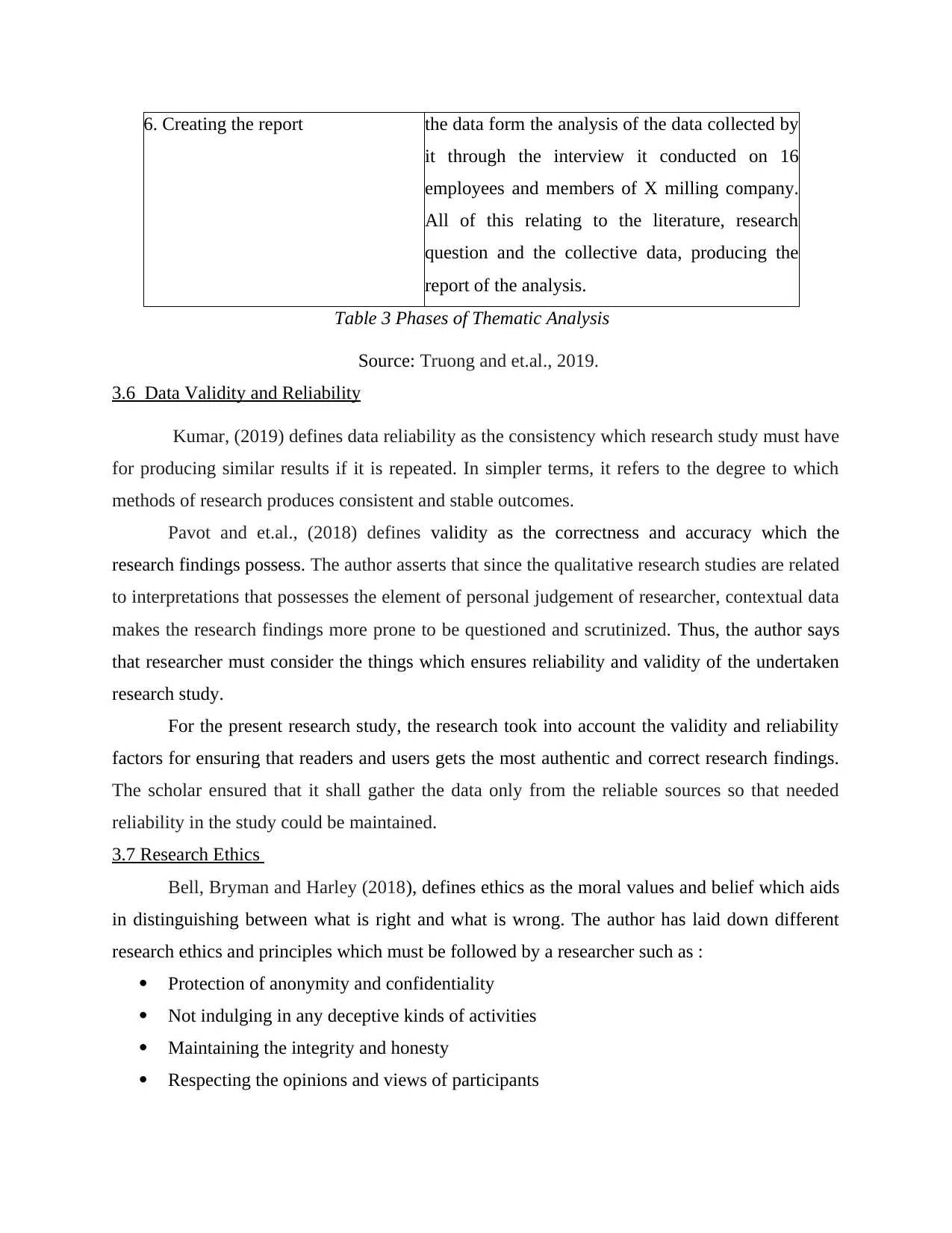
6. Creating the report the data form the analysis of the data collected by
it through the interview it conducted on 16
employees and members of X milling company.
All of this relating to the literature, research
question and the collective data, producing the
report of the analysis.
Table 3 Phases of Thematic Analysis
Source: Truong and et.al., 2019.
3.6 Data Validity and Reliability
Kumar, (2019) defines data reliability as the consistency which research study must have
for producing similar results if it is repeated. In simpler terms, it refers to the degree to which
methods of research produces consistent and stable outcomes.
Pavot and et.al., (2018) defines validity as the correctness and accuracy which the
research findings possess. The author asserts that since the qualitative research studies are related
to interpretations that possesses the element of personal judgement of researcher, contextual data
makes the research findings more prone to be questioned and scrutinized. Thus, the author says
that researcher must consider the things which ensures reliability and validity of the undertaken
research study.
For the present research study, the research took into account the validity and reliability
factors for ensuring that readers and users gets the most authentic and correct research findings.
The scholar ensured that it shall gather the data only from the reliable sources so that needed
reliability in the study could be maintained.
3.7 Research Ethics
Bell, Bryman and Harley (2018), defines ethics as the moral values and belief which aids
in distinguishing between what is right and what is wrong. The author has laid down different
research ethics and principles which must be followed by a researcher such as :
Protection of anonymity and confidentiality
Not indulging in any deceptive kinds of activities
Maintaining the integrity and honesty
Respecting the opinions and views of participants
it through the interview it conducted on 16
employees and members of X milling company.
All of this relating to the literature, research
question and the collective data, producing the
report of the analysis.
Table 3 Phases of Thematic Analysis
Source: Truong and et.al., 2019.
3.6 Data Validity and Reliability
Kumar, (2019) defines data reliability as the consistency which research study must have
for producing similar results if it is repeated. In simpler terms, it refers to the degree to which
methods of research produces consistent and stable outcomes.
Pavot and et.al., (2018) defines validity as the correctness and accuracy which the
research findings possess. The author asserts that since the qualitative research studies are related
to interpretations that possesses the element of personal judgement of researcher, contextual data
makes the research findings more prone to be questioned and scrutinized. Thus, the author says
that researcher must consider the things which ensures reliability and validity of the undertaken
research study.
For the present research study, the research took into account the validity and reliability
factors for ensuring that readers and users gets the most authentic and correct research findings.
The scholar ensured that it shall gather the data only from the reliable sources so that needed
reliability in the study could be maintained.
3.7 Research Ethics
Bell, Bryman and Harley (2018), defines ethics as the moral values and belief which aids
in distinguishing between what is right and what is wrong. The author has laid down different
research ethics and principles which must be followed by a researcher such as :
Protection of anonymity and confidentiality
Not indulging in any deceptive kinds of activities
Maintaining the integrity and honesty
Respecting the opinions and views of participants

Providing an option to the participants to withdraw at any time
Not forcefully taking the consent of participants
No biases and prejudices in obtaining and analysing the data (Warr and et.al.,2016)
In the current research study, the researcher used all the reasonable research ethics for
maintaining the integrity of the undertaken research. The scholar made sure that confidentiality
of the information is maintained. The scholar decided to share the information only with the
departmental heads of the company so that confidentiality is maintained. Moreover, it did not ask
any controversial questions to the participants. Further, the researcher attained the consent of
participants freely. Researcher sent emails to the employees for getting their approvals for the
face to face interviews. Scholar also facilitated the participants who were the employees and
member of X milling company to withdraw from the interview at any time.
3.8 Research Limitation
Warr and et.al., (2016), describes research limitation as shortcomings in the research
caused due to one or other factor. Absence of adequate time and money are two of the most
common research limitations which limits the scope of the research study. The author states that
a researcher must provide its limitations in the research study for facilitating the readers of the
study to clearly understand the conditions and circumstances under which the findings and
results of the study shall be interpreted.
The researcher in the current research study, has outlined time and money as its biggest
limitation which has narrowed down the scope of the study. These limitations were reflected in
the small sample size taken by the researcher. If adequate resources were provided, the sample
size could have bee taken bigger than the current sample size, which in turn would have provided
more enhanced and better results. Further if more money was facilitated, different statistical tools
could have been applied and the quantitative research would have been undertaken.
3.9 Conclusion
By looking at the above research methodologies, it can be concluded that for providing a
proper structure to research study, it is very essential for the researcher to employ correct and
appropriate research methods which compliments the study type and which helps the scholar in
attaining research aims and objectives. In the present research study, the scholar used the
qualitative research type and accordingly it used the research philosophy, sampling, data
collection method etc. Like the researcher has applied interpretivism research philosophy
Not forcefully taking the consent of participants
No biases and prejudices in obtaining and analysing the data (Warr and et.al.,2016)
In the current research study, the researcher used all the reasonable research ethics for
maintaining the integrity of the undertaken research. The scholar made sure that confidentiality
of the information is maintained. The scholar decided to share the information only with the
departmental heads of the company so that confidentiality is maintained. Moreover, it did not ask
any controversial questions to the participants. Further, the researcher attained the consent of
participants freely. Researcher sent emails to the employees for getting their approvals for the
face to face interviews. Scholar also facilitated the participants who were the employees and
member of X milling company to withdraw from the interview at any time.
3.8 Research Limitation
Warr and et.al., (2016), describes research limitation as shortcomings in the research
caused due to one or other factor. Absence of adequate time and money are two of the most
common research limitations which limits the scope of the research study. The author states that
a researcher must provide its limitations in the research study for facilitating the readers of the
study to clearly understand the conditions and circumstances under which the findings and
results of the study shall be interpreted.
The researcher in the current research study, has outlined time and money as its biggest
limitation which has narrowed down the scope of the study. These limitations were reflected in
the small sample size taken by the researcher. If adequate resources were provided, the sample
size could have bee taken bigger than the current sample size, which in turn would have provided
more enhanced and better results. Further if more money was facilitated, different statistical tools
could have been applied and the quantitative research would have been undertaken.
3.9 Conclusion
By looking at the above research methodologies, it can be concluded that for providing a
proper structure to research study, it is very essential for the researcher to employ correct and
appropriate research methods which compliments the study type and which helps the scholar in
attaining research aims and objectives. In the present research study, the scholar used the
qualitative research type and accordingly it used the research philosophy, sampling, data
collection method etc. Like the researcher has applied interpretivism research philosophy
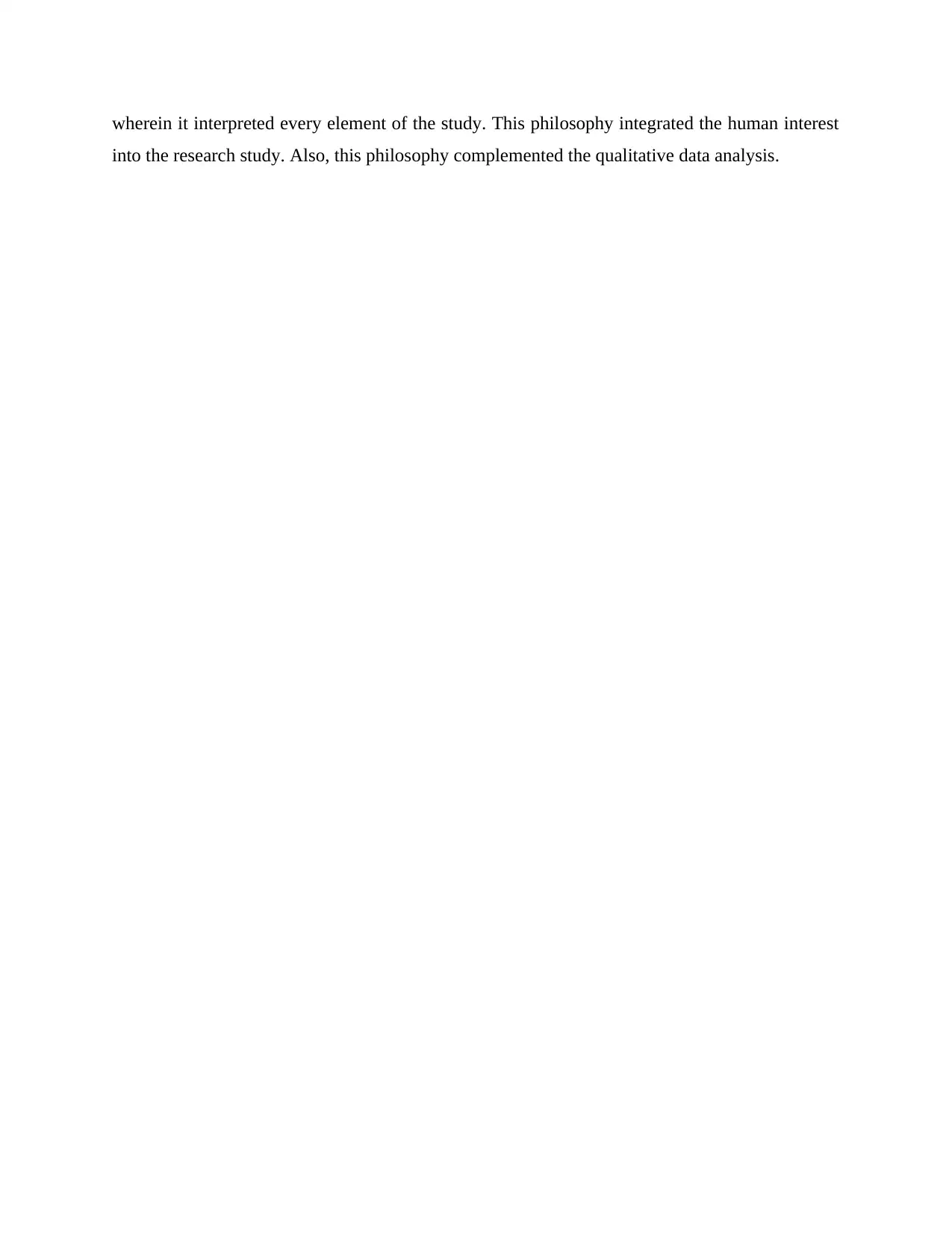
wherein it interpreted every element of the study. This philosophy integrated the human interest
into the research study. Also, this philosophy complemented the qualitative data analysis.
into the research study. Also, this philosophy complemented the qualitative data analysis.
Paraphrase This Document
Need a fresh take? Get an instant paraphrase of this document with our AI Paraphraser
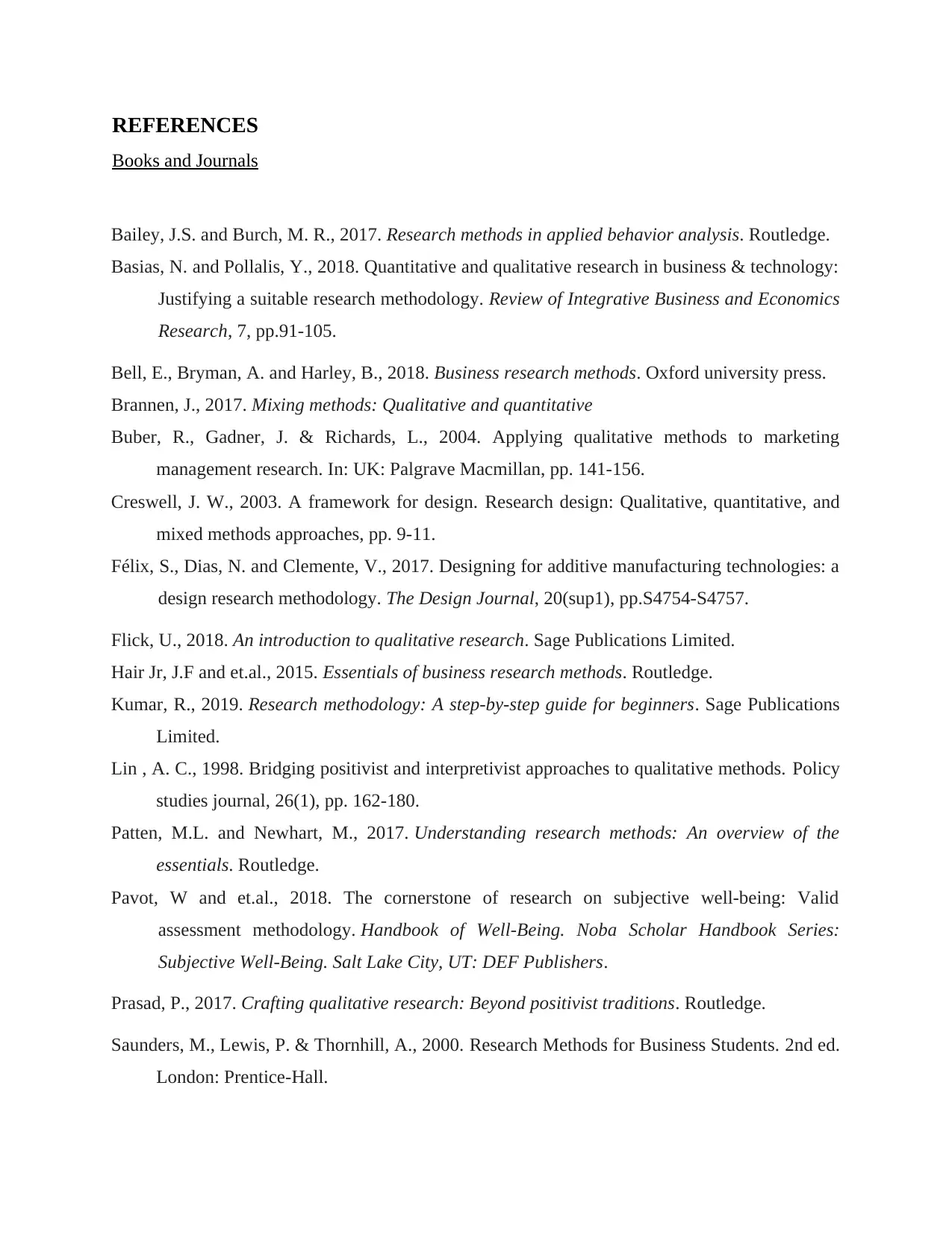
REFERENCES
Books and Journals
Bailey, J.S. and Burch, M. R., 2017. Research methods in applied behavior analysis. Routledge.
Basias, N. and Pollalis, Y., 2018. Quantitative and qualitative research in business & technology:
Justifying a suitable research methodology. Review of Integrative Business and Economics
Research, 7, pp.91-105.
Bell, E., Bryman, A. and Harley, B., 2018. Business research methods. Oxford university press.
Brannen, J., 2017. Mixing methods: Qualitative and quantitative
Buber, R., Gadner, J. & Richards, L., 2004. Applying qualitative methods to marketing
management research. In: UK: Palgrave Macmillan, pp. 141-156.
Creswell, J. W., 2003. A framework for design. Research design: Qualitative, quantitative, and
mixed methods approaches, pp. 9-11.
Félix, S., Dias, N. and Clemente, V., 2017. Designing for additive manufacturing technologies: a
design research methodology. The Design Journal, 20(sup1), pp.S4754-S4757.
Flick, U., 2018. An introduction to qualitative research. Sage Publications Limited.
Hair Jr, J.F and et.al., 2015. Essentials of business research methods. Routledge.
Kumar, R., 2019. Research methodology: A step-by-step guide for beginners. Sage Publications
Limited.
Lin , A. C., 1998. Bridging positivist and interpretivist approaches to qualitative methods. Policy
studies journal, 26(1), pp. 162-180.
Patten, M.L. and Newhart, M., 2017. Understanding research methods: An overview of the
essentials. Routledge.
Pavot, W and et.al., 2018. The cornerstone of research on subjective well-being: Valid
assessment methodology. Handbook of Well-Being. Noba Scholar Handbook Series:
Subjective Well-Being. Salt Lake City, UT: DEF Publishers.
Prasad, P., 2017. Crafting qualitative research: Beyond positivist traditions. Routledge.
Saunders, M., Lewis, P. & Thornhill, A., 2000. Research Methods for Business Students. 2nd ed.
London: Prentice-Hall.
Books and Journals
Bailey, J.S. and Burch, M. R., 2017. Research methods in applied behavior analysis. Routledge.
Basias, N. and Pollalis, Y., 2018. Quantitative and qualitative research in business & technology:
Justifying a suitable research methodology. Review of Integrative Business and Economics
Research, 7, pp.91-105.
Bell, E., Bryman, A. and Harley, B., 2018. Business research methods. Oxford university press.
Brannen, J., 2017. Mixing methods: Qualitative and quantitative
Buber, R., Gadner, J. & Richards, L., 2004. Applying qualitative methods to marketing
management research. In: UK: Palgrave Macmillan, pp. 141-156.
Creswell, J. W., 2003. A framework for design. Research design: Qualitative, quantitative, and
mixed methods approaches, pp. 9-11.
Félix, S., Dias, N. and Clemente, V., 2017. Designing for additive manufacturing technologies: a
design research methodology. The Design Journal, 20(sup1), pp.S4754-S4757.
Flick, U., 2018. An introduction to qualitative research. Sage Publications Limited.
Hair Jr, J.F and et.al., 2015. Essentials of business research methods. Routledge.
Kumar, R., 2019. Research methodology: A step-by-step guide for beginners. Sage Publications
Limited.
Lin , A. C., 1998. Bridging positivist and interpretivist approaches to qualitative methods. Policy
studies journal, 26(1), pp. 162-180.
Patten, M.L. and Newhart, M., 2017. Understanding research methods: An overview of the
essentials. Routledge.
Pavot, W and et.al., 2018. The cornerstone of research on subjective well-being: Valid
assessment methodology. Handbook of Well-Being. Noba Scholar Handbook Series:
Subjective Well-Being. Salt Lake City, UT: DEF Publishers.
Prasad, P., 2017. Crafting qualitative research: Beyond positivist traditions. Routledge.
Saunders, M., Lewis, P. & Thornhill, A., 2000. Research Methods for Business Students. 2nd ed.
London: Prentice-Hall.
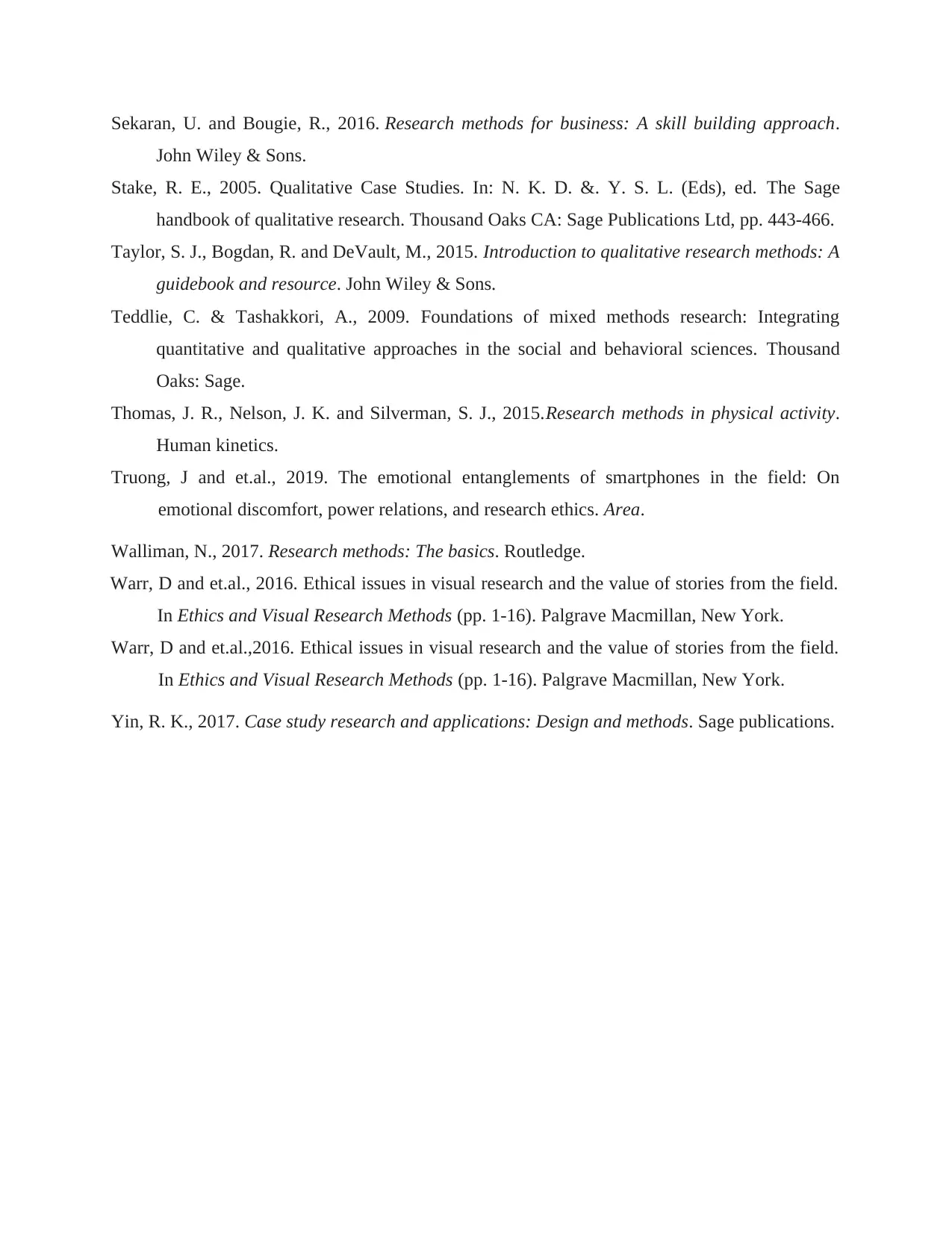
Sekaran, U. and Bougie, R., 2016. Research methods for business: A skill building approach.
John Wiley & Sons.
Stake, R. E., 2005. Qualitative Case Studies. In: N. K. D. &. Y. S. L. (Eds), ed. The Sage
handbook of qualitative research. Thousand Oaks CA: Sage Publications Ltd, pp. 443-466.
Taylor, S. J., Bogdan, R. and DeVault, M., 2015. Introduction to qualitative research methods: A
guidebook and resource. John Wiley & Sons.
Teddlie, C. & Tashakkori, A., 2009. Foundations of mixed methods research: Integrating
quantitative and qualitative approaches in the social and behavioral sciences. Thousand
Oaks: Sage.
Thomas, J. R., Nelson, J. K. and Silverman, S. J., 2015.Research methods in physical activity.
Human kinetics.
Truong, J and et.al., 2019. The emotional entanglements of smartphones in the field: On
emotional discomfort, power relations, and research ethics. Area.
Walliman, N., 2017. Research methods: The basics. Routledge.
Warr, D and et.al., 2016. Ethical issues in visual research and the value of stories from the field.
In Ethics and Visual Research Methods (pp. 1-16). Palgrave Macmillan, New York.
Warr, D and et.al.,2016. Ethical issues in visual research and the value of stories from the field.
In Ethics and Visual Research Methods (pp. 1-16). Palgrave Macmillan, New York.
Yin, R. K., 2017. Case study research and applications: Design and methods. Sage publications.
John Wiley & Sons.
Stake, R. E., 2005. Qualitative Case Studies. In: N. K. D. &. Y. S. L. (Eds), ed. The Sage
handbook of qualitative research. Thousand Oaks CA: Sage Publications Ltd, pp. 443-466.
Taylor, S. J., Bogdan, R. and DeVault, M., 2015. Introduction to qualitative research methods: A
guidebook and resource. John Wiley & Sons.
Teddlie, C. & Tashakkori, A., 2009. Foundations of mixed methods research: Integrating
quantitative and qualitative approaches in the social and behavioral sciences. Thousand
Oaks: Sage.
Thomas, J. R., Nelson, J. K. and Silverman, S. J., 2015.Research methods in physical activity.
Human kinetics.
Truong, J and et.al., 2019. The emotional entanglements of smartphones in the field: On
emotional discomfort, power relations, and research ethics. Area.
Walliman, N., 2017. Research methods: The basics. Routledge.
Warr, D and et.al., 2016. Ethical issues in visual research and the value of stories from the field.
In Ethics and Visual Research Methods (pp. 1-16). Palgrave Macmillan, New York.
Warr, D and et.al.,2016. Ethical issues in visual research and the value of stories from the field.
In Ethics and Visual Research Methods (pp. 1-16). Palgrave Macmillan, New York.
Yin, R. K., 2017. Case study research and applications: Design and methods. Sage publications.

Secure Best Marks with AI Grader
Need help grading? Try our AI Grader for instant feedback on your assignments.

1
1 out of 17
Related Documents
Your All-in-One AI-Powered Toolkit for Academic Success.
+13062052269
info@desklib.com
Available 24*7 on WhatsApp / Email
![[object Object]](/_next/static/media/star-bottom.7253800d.svg)
Unlock your academic potential
© 2024 | Zucol Services PVT LTD | All rights reserved.





